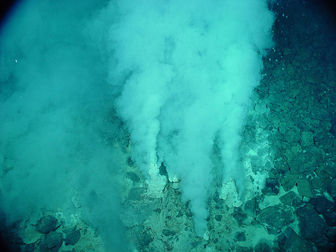Hydrothermal vents

Facts about Hydrothermal vents
How do hydrothermal vents form? In some areas along the Mid-Ocean
Ridge, the gigantic plates that form the Earth's crust are moving
apart, creating cracks and crevices in the ocean floor.
Hydrothermal vents are abundant on Earth because it is both
geologically active and has large amounts of water on its surface.
Common land types include hot springs, fumaroles and geysers.
Hydrothermal vents were discovered in 1977 in the Pacific Ocean. Since
then, they have been found in the Atlantic, Indian, and most recently,
the Arctic Ocean.
provided images of hydrothermal vents in the first two years, and now
has geodetic and chemical sampling capability.
Hydrothermal vents are locally very common because the earth is both
geologically active and has large amounts of water on its surface and
within its crust. Common land types include hot springs, fumaroles and
geysers.
Active hydrothermal vents are believed to exist on Jupiter's moon
Europa, and ancient hydrothermal vents have been speculated to exist
on Mars.
hydrothermal vents contain low amounts of manganese, sulfate, and
elemental sulfur, while being abundant in silica, metals and dissolved
gases.
hydrothermal vents and their ecology, from Washington
State University
* Black Smoker Chimneys - from Access Excellence
Phase 2 - Looking Deeper from Different Perspectives
* Seafloor vents are often called hydrothermal vents: hydro means
water and thermal means hot.
* When it exits the seafloor, vent fluid temperature can beas high
as 350°C (675°F) or hotter.
Perhaps the most striking feature of sea-floor hydrothermal vents is
their dense biologic communities. Vent faunas tend to be dominated by
mollusks, annelids, and crustaceans, whereas faunas on nonvent
hard-bottom habitats consist predominantly of cnidarians, sponges, and
echinoderms.
Hydrothermal vents are cracks in the ocean floor that emit jets of hot
water loaded with minerals and bacteria. The vents range in diameter
from less than an inch to mare than six feet.
Hydrothermal vents are fissures in the ocean floor that leak hot,
acidic water. The size of the opemings range from less than half an
inch to more than six feet in diameter.
the hydrothermal vents though the exact make-up of the biological
community surrounding them depends on the chemicals, such as hydrogen
sulfide, methane, iron, manganese and silica, found in the cold-seep
fluid.
numerous and spectacular hydrothermal vents are found along worlds
mid-ocean ridges. The heat source for these springs is the magma
(molten rock) beneath the volcanic ridge system.
Earth Observatory have found evidence of hydrothermal vents on the
seafloor near Antarctica, formerly a blank spot on the map for
researchers wanting to learn more about seafloor formation and the
bizarre life forms drawn to these extreme environments.
Hydrothermal VentsPage 1 of 1 Return to the Deep Sea Creatures Menu
Deep Sea Hydrothermal Vents
=
Giant tube worms surrounding a hydrothermal vent
Giant Tube Worms Near
a Deep Sea Hydrothermal Vent.
Since their discovery in 1977, hydrothermal vents have been found
along mid-ocean ridges on the seafloor of the Pacific, Atlantic, and
Indian Oceans. These natural, deep-sea plumbing systems ventilate heat
and minerals from the interior of the Earth, while supporting complex
ecosystems of exotic organisms.
